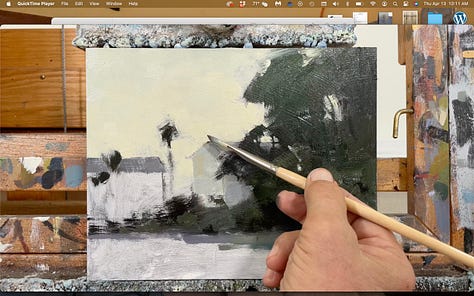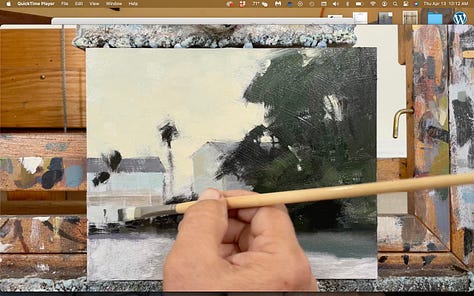This week I’m posting some work in progress. These are all on 8”x10” Ampersand 1-1/2” deep, hardboard cradled panels with one coat of Golden Gloss Medium to seal from SID (surface induced discoloration), followed by two coats of the white Michael Harding’s Non-absorbent acrylic primer. Although these are all oil paintings, I’m still sealing them from SIDS in case I end up painting them in acrylic instead. When I prepare a number of panels, I never know for sure when I do that if they’ll be used for oils or acrylics. Better safe than sorry.
I like this combination of products (all linked above) for a few reasons. The Ampersand cradled panel is a little more spendy than others on the market. But they’re nicely constructed and always square… an issue with some of the others that I’ve purchased. I like the hardboard version because it’s cheaper and very durable. No chance of a wayward splinter or grain of wood showing up where I don’t want it. Even after priming, I’ve had a visible defect showing because the birch itself had a defect in it. Those are very hard to cover up unless you’re applying very heavy paint. The Michael Harding NAPrimer is really nice to paint on, in both oils and acrylics. I’m not exactly sure why, yet, but I think it has to do with its level of “slippery” vs “absorbent”. I love and have used Lascaux ‘gesso’ and ‘primer’, both acrylic primers, for years. But their “gesso” is more aggressively dry, and the primer is a little too plastic like, compared to the MHarding primer. I’m still trying to figure this out, but for now everything is being primed with the MH primer. As I you saw in the demo clip last week, I apply a toned wash on the dry primer first, then begin painting with whatever medium I’m using.
( Disclaimer… none of this may be valid next week. I’m always experimenting with these things and never resist a temptation to try something new. )
A question came up from another artist, who is about my age, about painting over acrylic primer with oil paints. His question was about the archivability of doing that. If you weren’t painting 30-40 year ago, you probably haven’t been told that you can NOT paint oil paints over an acrylic primer or painting. If you were, you know what I’m talking about. The science since then, and some amount of the good old “test of time”, has enlightened us so that we now know that oil paint adheres very well to a “good” acrylic primer, that the acrylic primer is porous enough to create a very good bond between it and the oil paint as it dries. Today, nearly every canvas and board made and/or sold by reliable art stores and art supply dealers, is acrylic primed. Unless… you’re specifically looking for an oil or lead primed version of those things, which many of them do sell, you’re probably painting on acrylic. Here’s Golden Paints information page about this. In the field it gives me some choices. If I want to use acrylic or oil, or it allows me to tone a panel or canvas with an ‘appropriate’ acrylic wash on the spot that is dry and ready to be painted on in a few minutes. On the other hand, if I use an oil wash, it sits in it’s wet state for a long time, and is pulled up by subsequent application of wet paint. Not a horrible thing, but annoying if that burnt sienna tone ends up in your nice, light value pale blue sky. In the field I carry a tube of burnt sienna, a blue like cobalt or ultramarine, and a raw umber. I can cover most needs for a tone with these three pigments.
Side note - Personally, I used to hate painting on acrylic priming. But I’m over it and actually prefer it to oil or lead primers… EXCEPT… for one… Natural Pigments Rublev Lead Alkyd Ground! This is the Premium primer for oil paints in my own opinion. It dries fast enough to be ready to paint on in a day or two, waiting longer lets it cure more and it’s even nicer to paint on. If I didn’t also want to paint in acrylics at times, this is THE Only primer I would use, ever. It’s also a perfect primer to over prime paintings that didn’t work out.
I’m posting a few still shots from this weeks paid subscription demo step, and these works in progress for you all. If you’d like to see or read more, please consider a paid subscription. Thanks for your time.
Cheers,
Marc








Your newsletters and demos are great. Inspiring and informative- perfect combination.
I’m wondering about your treatment of the sides of 1.5” deep panels. Do you prime them and leave them white or tape over edge and leave them plain or carry your painting over the side? Curious because I use floater frames also. Thanks!
Marc, would you mind sharing what tool you use to apply the gesso/primer? Looks like maybe a stiff brush? Thanks!